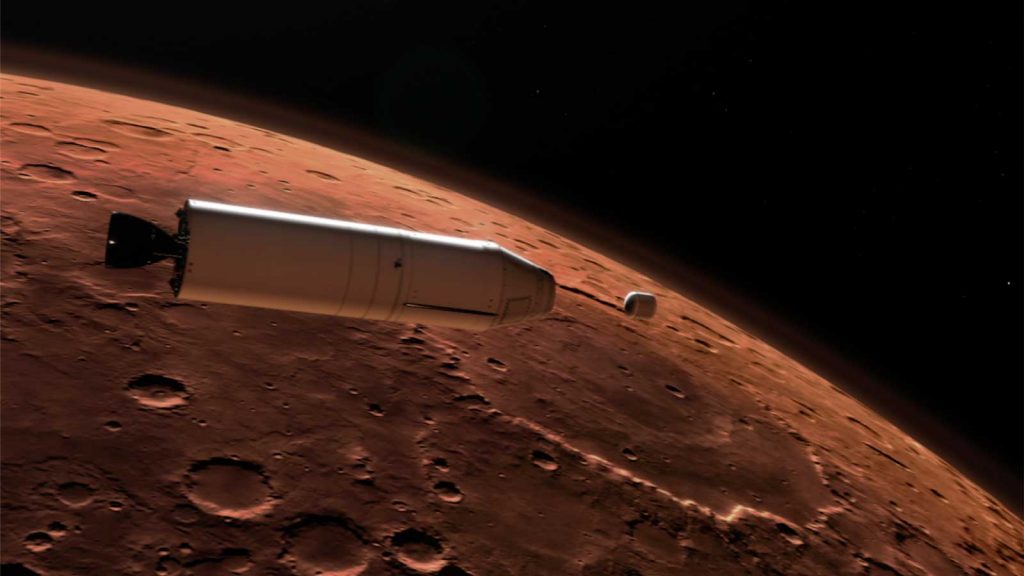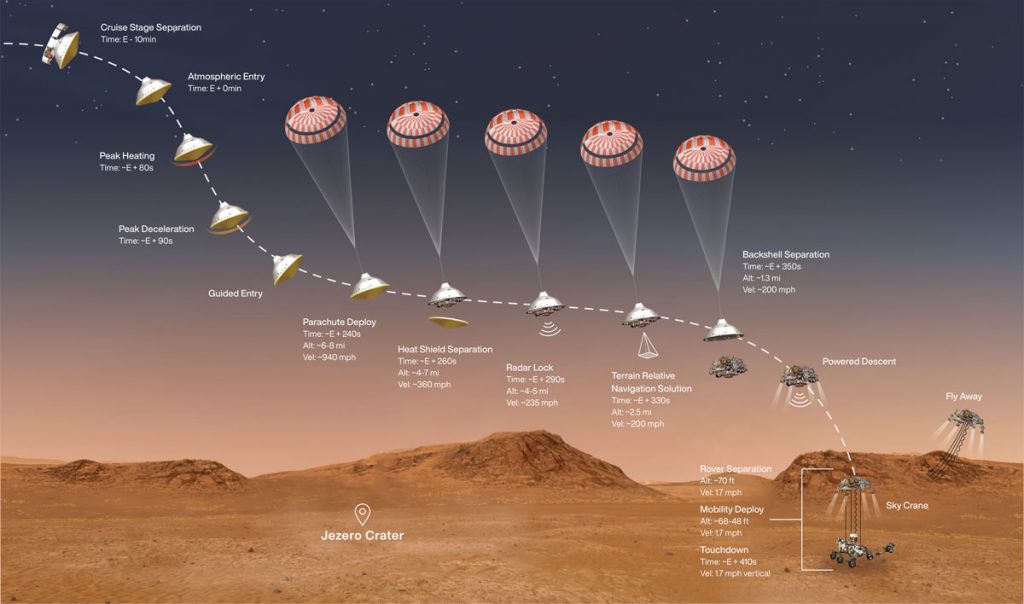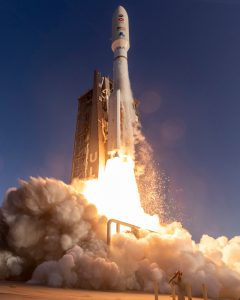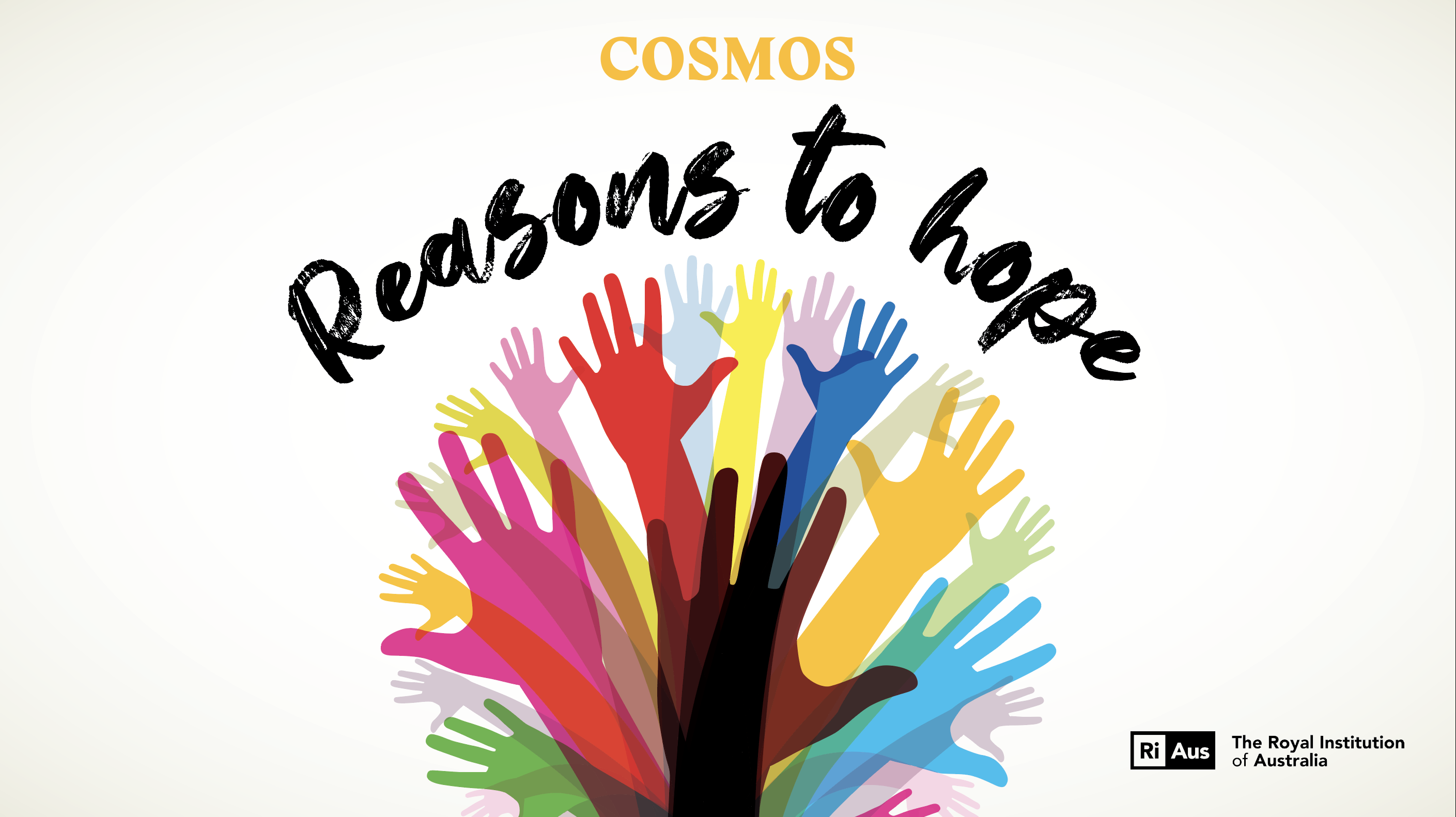How to land a Mars rover when you’re many, many millions of kilometres away.
This resource explains each of Newton’s laws and how they are used to land rovers, like Perseverance, on Mars. It is best suited to Year 7 and 10 Physics students.
Word Count / Video Length: 1118 / 3:25 mins / 2:59 mins

It takes a lot of thought and a lot of work to land a rover on Mars. It’s not as if you’re on Earth, where you can check things out, take a few samples and make necessary measurements directly.
To get a lander like Perseverance down, scientists and engineers must take into account such things as the target planet’s gravity, the speed the rover will be travelling and the condition of the landing surface.
Thankfully, one important person has made calculating these things a lot easier: Sir Isaac Newton.
Projectile motion
Landing anything on a foreign planet requires planning, including determining where to land. These missions cost billions of dollars and years of time just to design and construct them. What if there was a storm the day the rover was due to land? Or if there was a quake and the landing site was destroyed?
Good thing there are satellites monitoring storms and quakes on Mars. This means that surface conditions are known in advance – just like us checking the weather forecast before we pick our shoes for the day.
The Chinese rover Tianwen-1 entered Mars’ orbit on 10 February 2021, and will remain in orbit for a couple of months to examine its landing site before deploying its lander and rover for touchdown.
A satellite is also the perfect place for the rovers to send their data before it comes back to Earth.

To understand how satellites orbit, first let us think about throwing a ball. The launched ball will travel both horizontally along and vertically down to the ground. It moves horizontally because you provide it with a horizontal force in the throw and it travels down because of the force due to gravity.
If you throw the ball harder, it will travel further horizontally but it will take the same time to hit the ground because the force due to gravity (9.8 Nkg (or 9.8 ms-2) on Earth) remains the same.
If you take the ball higher, it will also take longer to reach the ground as the vertical distance is larger.
Now, if you take the ball high enough and launch it with enough force, it will move with the same horizontal and vertical motions as our first ball but, will keep missing the Earth since the planet is round. This is exactly how a satellite (including the Moon) stays in orbit: it is always falling towards the Earth but it keeps missing and travels around the planet.
Newton’s first law
As a satellite orbits a planet, the horizontal forces acting on the satellite are balanced. This is because there are virtually no frictional forces. This means that the satellite can continue to orbit, gathering data, without the need for a driving force, like a motor.
Newton’s first law explains this to us.

The first law states: An object at rest will remain at rest, and an object in motion will remain in motion, travelling at the same speed and direction, unless acted upon by an unbalanced force.
Both the Tianwen-1 and Perseverance communication satellites are moving relative to the surface of Mars and are therefore in motion. As no external unbalanced forces are acting upon them, we know that they will continue at the same horizontal speed as long as we need them to.
When Tianwen-1’s lander and rover are ready to descend, its thrusters will be used. These create an unbalanced force that pushes the lander and rover out of orbit and down to Mars.
The thrusters are also needed to slow it to a stop on the surface so it doesn’t crash onto Mars. Knowing how much force is needed requires Newton’s second and third laws.
Newton’s second law
At the same time as writing his first law, Newton recognised that there was a relationship between the unbalanced force exerted on an object, the mass of that object and the acceleration it would have from the force.
He identified that the larger the unbalanced force, F, applied on an object of mass, m, the higher the acceleration, a, would be.
From this, he deduced and wrote his second law: Force (unbalanced) = mass x acceleration.
The Perseverance lander unit had a mass of 1025 kg and so we can use Newton’s second law to calculate the downward force acting on the lander. Mars has an acceleration due to gravity of 3.69 ms-1 and so the downward force is:
F = 1025 x 3.69 = 3782 N
Note: This is a simplified, ideal scenario where we have ignored any drag or other frictional forces.
A parachute was used to slow Perseverance as it hurtled towards the surface of Mars with this force. The parachute provided an upward force on the lander, which reduce the unbalanced force.

Newton’s third law
To lift a rocket off the Earth, it expels gas towards the ground. Newton’s third law explains how pushing gases downwards, lifts a rocket up.

The third law states that every action has an equal (in magnitude) and opposite (in direction) reaction.
So, as the gases are pushed out and down, they push back up on the rocket, lifting it upward. The size of the downward force on the gases will be the same size as the resultant force on the rocket.
If enough upward force is made by the gases, it will be greater than the downward force due to gravity acting on the rocket. This resultant unbalanced force moves the rocket in the direction of the greater force (so in this case, up) as described by Newton’s second law.
Thrusters and boosters were also used to land the rover. Gases were forced down and out of the thrusters and so the gases applied an equal force, in the opposite direction, back onto the thrusters. This slowed the speed of the rover enough to land on Mars without crashing.
Engineers and scientists use very precise calculations to ensure that the downwards force on the rover is only a small amount higher than the upwards force of the thrusters (remember the first law tell us if they were exactly equal, or balanced, the rover would just ‘hover’ where it was). The result was a smooth and gentle landing with no damage to the expensive equipment – and an incredibly cool video.
Spaceship engineers, mathematicians, geologists, astrophysicists, data scientists, fuel chemists and a whole range of other people all had to work together to help Perseverance land on Mars. But they always had Newton in the pilot’s seat.
Now, with the rover safely on the surface of Mars, the next stage of the mission can begin – searching for ancient life!
This article is republished from Cosmos. Read the original article.
Login or Sign up for FREE to download a copy of the full teacher resource





